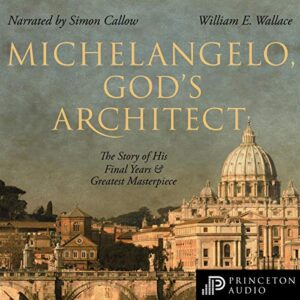Michelangelo, God\’s Architect audiobook
Hi, are you looking for Michelangelo, God\’s Architect audiobook? If yes, you are in the right place! scroll down to Audio player section bellow, you will find the audio of this book. Right below are top 5 reviews and comments from audiences for this book. Hope you love it!!!.

Review #1
Michelangelo, God\’s Architect audiobook free
About a month after Michelangelo’s death, Jacopo da Castiglione, wagon driver, delivered four marble columns, bases, and capitals to the construction site of the new Church of Santa Maria delgi Angeli being built within the ruins of the ancient Roman Baths of Diocletian. This was unusual. Records from the time show purchases of raw materials, including bricks, volcanic sand, tufa, travertine, and lime, all likely brought from quarry sources rather than having been plundered from the remains of the ancient city itself. Mining the local ruins would have been far less expensive, but as far back as the Fifth Century rule of Theodoric the Great, rulers of Rome had defended the preservation of what remained of the ruined city as a means of attaching themselves to the grandeur of classical Rome, thus asserting their legitimacy as Rome’s current rulers. On the relentless centuries-long program of burning marble for lime and melting bronze treasures for raw metal, Robert Hughes writes, The Romans had done more damage to Rome than the worst barbarian invasions.
From the early 14th century Rome’s civic government considered the preservation and/or restoration of antique architecture a primary duty, but after the return of the Holy See in 1420, these civic governors began to lose control of these duties to papal authority. Thus it was that when in 1561, Pope Pius IV decided to build a new church using the Baths of Diocletian as a sort of shell, authority over the ruins was asserted whole. He turned the project over to Michelangelo. The first construction contracts were issued April 1563. Michelangelo had only ten more months to live. Yet in that time he swiftly designed an inventive new church within the ruins, and did so with what appears to be a severe understanding of the necessity to do as little as possible to the ancient structure, and to acquire new materials not by despoiling surrounding ruins, rich in building materials, but to stick to the now centuries-old respect for the ruins of Rome and acquire his construction materials fresh from the ground.
This respect for the ancient had uses other than political. The idea of bringing ancient structures back to life was consonant with the Christian concept of the resurrection of the body, and while Michelangelo, rapidly approaching a long-dreaded death, respected the ethos of renovation, it is possible that he also understood it as a personal metaphor for his own mortality. But as soon as Michelangelo was no longer around to stop them, others less concerned with the idea of the conservation of old Rome quickly turned to pillaging nearby ruins again, as the story of Jacopo the wagoneers delivery of marble columns and capitals tells us.
Michelangelo had not stayed in school long enough to learn to read Latin or Greek, and he seems to have been bothered by this. William E. Wallace’s new book, “Michelangelo, God’s Architect,” makes it clear that the artist was solicitous of the refined group of friends he spent time with. This small observation encapsulates one of Wallace’s personal missions: to rescue Michelangelo from the myth that has grown up around him, casting him as a grouchy, depressed loner, friendless and (in some observers’ views) even diagnosable. I can say it no better that Paul Barolsky: Although Michelangelo was a real person . . . he nevertheless exists in our imagination largely as a mythic being. We do not much think of the real Michelangelo, for example, eating with pleasure the marzolino cheese, sausages, ravioli, beans, and choice pears that his nephew in fact sent to him in Rome.
In his “Michelangelo: The Artist, the Man and His Times” and “Michelangelo at San Lorenzo: The Genius as Entrepreneur,” Wallace established Michelangelo as an engineer and project manager able to organize and motivate large work crews committed to huge architectural undertakings, which requires fine people skills. This was no stormy curmudgeon. At home with bricklayers and popes, quarrymen and Dukes, Michelangelo was anything but the caricature that history, beginning with Vasari, has made of him.
Wallace asserts that Michelangelo became an architect with his design of the ill-fated facade for Florence’s Church of San Lorenzo, but he begins with a spirited defense of the final version of the Tomb of Julius II. While this tomb is generally dismissed by the likes of Timothy Clifford as an appalling mess and Timothy Verdon as an amazing humiliation, and even counted in Condivi’s biography of the artist as the tragedy of the tomb (which biography is generally thought to have been essentially dictated to Condivi by Michelangelo himself), Wallace imagines the final evening of the tomb’s completion, the artist lingering at the site in the church of San Pietro in Vincoli. Did it bother the artist that the tomb erected in San Pietro in Vincoli was significantly different from what he had first conceived? After four decades and innumerable delays, Michelangelo finally had created a decorous and moving monumentgrand rather than grandiose, inspired more by Christian sentiment than pagan ambition. Wallace then notes that, Michelangelo was seventy years old.
In the online magazine MarketWatch, Wallace published in November 2019 the spine-stiffening essay, Michelangelo Found a New Career after 70 Why Cant You? He concludes, Thanks to what Michelangelo accomplished in his final years, Rome once again could claim its place as the capital of the worldCaput Mundi. It is easier to admire his achievement than to imagine ourselvesin our 70s or 80sembarking on a whole new career. But, perhaps, like Michelangelo, we are just entering the busiest and most creative years of our lives.
Elsewhere Wallace admits that after age 60, he gave up his trademark classroom back-flips. The emphasis in the new bookbeginning with the artist turning 70, and marching onward to within a few days before Michelangelo died a month before he turned 90, working hard, even carving marble up to the endsuggests that this work is in part Wallace’s own meditation on age. Wallace turned 67 the same month that the MarketWatch essay was published in advance of the book under review here. I wrote to him the following: Given that I turned 68 yesterday, your optimistic encouragement about 70 being the new 30 (I suppose) and that the remaking of oneself as demonstrated by the indefatigable Michelangelo is, really, the only rational path, I intend to do just that. I am trying to see 68 not as a countdown but a tallying of accumulated year/credits the way one might look at a shelf of published books.
But even with his life of failed projects, Michelangelo, all too aware of what stood in the way of the slowly rising Saint Peter’s, knew that vast construction project that would inexorably rise, turning Rome from the medieval city of bell towers to a city of domes. Wallace writes, In late life, Michelangelo was less concerned with creating the unique works that propelled his rise to fame than with finding the courage and devotion to continue tasks that he knew he would never see to fruition. By gaining the trust of patrons, influential friends, hand-picked supervisors, and younger artists sensitive to his intentions, Michelangelo ensured the eventful completion of his many projects, even long after his death.
Here Wallace knits his two projects into one: Michelangelo, the warm and gracious friend and family man with Michelangelo the genius of gargantuan projects. As Wallace suggests, if Michelangelo can do it even during the last two decades of his life starting at age 70, we ought to be able in our own small to way follow his lead.
Michelangelo, God’s Architect is a necessary book, filling in important gaps in the conventional wisdom, fleshing out the man and exploring the often-neglected period of his later life as the architect of Rome. And it may have personal benefits for its readers, among whom will be those contemplating their own legacies.
Review #2
Michelangelo, God\’s Architect audiobook streamming online
I had the privilege of taking Art History 101 with Professor Wallace at WU in St. Louis back in the 90’s. I was a junior at the time, so it was probably too late to change from an English major to an Art History major but either way, he opened my eyes to the world of art. I still remember his gift for taking the students “behind the scenes” of works of art and he would delve into the minds of the artists, allowing us to understand what the artist was thinking and what he/she was trying to achieve. Professor Wallace can do this brilliantly for all art mediums, be it be architectural, sculpture, painting, or something else.
This gift for teaching students/readers about works of art shines through in “Michelangelo, God’s Architect.” The book discusses Michelangelo’s last 10-15 years of life and his obsession with building the New St. Peter’s Cathedral. I have been to Rome many times and like many others, I thought Michelangelo’s crowning achievement in Vatican City is the Sistine Chapel. Of course, that is a masterwork but Professor Wallace makes a very convincing argument that, in fact, St. Peter’s was Michelangelo’s greatest accomplishment, given his age at the time, given the sheer complexity of the project and given that architecture was not his primary medium.
Professor Wallace also explains why Michelangelo was, in ways, the first celebrity architect and how Michelangelo pretty much threw out the book of architecture and did things his way, creating an architectural vocabulary that is still used to this day.
I read this book in a couple of days, and I am a slow reader. It is about 250 pages. The book motivated me to do more research on the topic, including reading about the marble quarries in Carrara and reading more about the creation of the “New St. Peter’s,” which took over 100 years to build. In other words, this book not only taught me many things, it motivated me to learn even more on the subject. A must-read for any art history enthusiast.
Review #3
Audiobook Michelangelo, God\’s Architect by William E. Wallace
After reading Ross King’s Brunelleschi’s Dome, Leonardo and the Last Supper and Michelangelo and the Sistine Chapel, I was hoping to read a book about the art and architecture of St. Peter’s basilica. This book is truly about the life and times of Michelangelo and not very much about his art. The book begins with moving the monumental statue of Moses out of his home and doesn’t discuss its creation or world wide impact through the years. It talks a lot about his trips from home to St. Peters and how Michelangelo was a great project manager, but not much about the actual architecture of the basilica. It was an interesting read and is true to the name of the book. If you want to know more about early 16th century Rome, read this book. If you’re interested in how the largest church in Christendom was actually built, don’t waste your time.
Review #4
Audio Michelangelo, God\’s Architect narrated by Simon Callow
My husband bought me this book (because I read everything I can find on Michelangelo and, long ago I once briefly studied under Dr. Wallace at Wash U), and I read it in 2 days; rarely do I read a book that provides such fresh insight into Michelangelo, but this book made me reenvision the artist yet again. It broke Michelangelo open for me in a new way. I was particularly taken by the empathy with which this book explores the journey of aging as an artist… the strains an aging body puts on the physical process of creation (especially for a marble sculptor, frescoist, and architect) and the mental struggle of knowing that you may never again achieve what you did in your youth or that you may never live to see your current projects completed… Even though it’s definitely a serious piece of art historical research, it’s also a deeply touching book. I can’t recommend it highly enough for anyone interested in Michelangelo, the creative process, or aging… Just beautiful. Okay, I must go now and read it again.
Review #5
Free audio Michelangelo, God\’s Architect – in the audio player below
Very good, but repetitive in many places.
Galaxyaudiobook Member Benefit
- Able to comment
- List watched audiobooks
- List favorite audiobooks
GalaxyAudiobook audio player
If you see any issue, please report to [email protected] , we will fix it as soon as possible .






